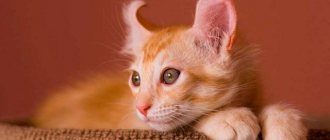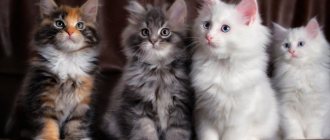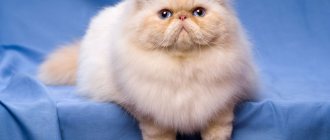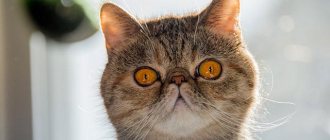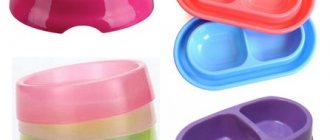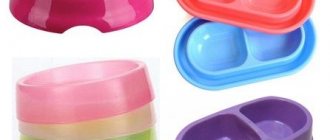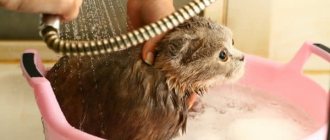Features of fluffy cat breeds
Long-haired cats have a special coat structure: the hairs are quite dense and the undercoat is thick. During seasonal molting, animals are forced to lick dead hairs every day. This routine procedure helps to renew the coat, but most of the hairs remain in the stomach, which causes a lot of trouble. Owners should provide pets with sprouted oat or wheat sprouts to remove hairballs.
Long-haired fluffies have a tendency to develop tangles. Regular licking and combing of the hairs will help solve the problem.
Free range can also ruin the appearance of furry beauties. Dust, debris, thorns, dry leaves are what cats often return from a walk with.
Certain breeds of cats shed all year round, which adds to the worries of their owners. In other breeds, the coat grows back darker after clipping, which leads to disqualification at the show.
The high likelihood of allergic reactions in family members is another feature of fluffy cat breeds. During the molting season, hairs cover literally everything around, clumps of fluff get stuck in corners and under furniture, which complicates cleaning the room. Such animals will have to comb their fur every day. By the way, a robot vacuum cleaner will take on some of the routine work and make life much easier for cat owners.
Advantages and disadvantages
Dense and thick wool has its advantages, but it is not without its disadvantages.
A warm coat protects the animal from the cold, but in summer it can become a real problem. If the owner neglects hygiene rules, the animal runs the risk of developing skin diseases. To maintain an attractive exterior, you will need hard brushes, slicker brushes, combs, and furminators.
In some cat breeds, the fur is prone to fading, so owners should ensure that their pets do not walk under the scorching sun. Under the influence of ultraviolet light, the hairs become dry and brittle.
Long-haired cats often resist when the owner tries to comb their coat, which makes grooming more difficult. Few of the cat family like water treatments, which cannot be avoided if the pet is free-range. Ticks and fleas hide in a thick fur coat and are often invisible. To remove fleas, medications are used that have a negative effect on the coat: the hairs lose their elasticity, become dull and brittle.
Sacred Burma
Long-haired Siamese cats with cornflower blue eyes. White markings on paws are required - short gloves. The build is graceful, the size is average, although the fluffy fur may make the cat seem large. Good health, unless there is congenital polycystic disease or amyloidosis.
It is believed that these cats lived in the Buddhist temples of Burma, accompanying the monks. They are clean, do not spoil things, easily learn to be tidy, and do not make noise. These are calm, peace-loving pets, sophisticated and delicate. The Burma needs a loving owner who does not mind close contact. Noisy children are not too welcome, but they are patient.
Furry breed categories
Cat breeds receive official recognition after passing certification in one of the felinological communities. Animals receive metrics, pedigree and documentary evidence of origin. The exterior must comply with the breed standard. Only a complete package of documents gives the right to selection and participation in exhibitions.
There are more than 700 special species of cats in the world, but international organizations recognize only a few dozen:
- FIFe (World Cat Federation) recognizes 42 breeds.
- European WCF - 70 breeds;
- American CFA Association - 40 breeds.
Breeding work is ongoing, so some resistant phenotypes will periodically receive official recognition.
According to FIFe
According to FIFe, furry varieties include categories I and II, which include the following breeds:
- American Longhaired Curl.
- Balinese cat.
- Burma.
- British.
- Himalayan cat.
- Maine Coon.
- Neva Masquerade.
- Norwegian forest.
- Persians.
- Ragdoll.
- Siberian cat.
- Turkish Angora.
- Turkish van.
- Exotic.
Ragdoll
According to WCF version
According to WCF, furry cat varieties include breeds of categories 1 and 2:
- Long-haired Burmilla.
- Karelian Bobtail
- Kurilian Bobtail.
- Laperm.
- Munchkin.
- Nibelung.
- Oriental.
- Ragamuffin.
- Selkirk rex.
- Somali cat.
- Tiffany.
- Ural rex.
- Highland fold.
- Japanese Bobtail.
Ragamuffin
According to CFA
The CFA recognizes the same cat species as the WCF and FIFe with the exception of: American Bobtail, Ojos Azules, Pixie Bob.
Turkish Angora
One of the oldest breeds, whose ancestors, together with Van cats, were brought to Europe in the 14th century. Small, elegant pets with a wedge-shaped head and a narrow, elongated muzzle. The coat is friable, thin, almost without undercoat. We allow different eye colors. Congenital deafness occurs in white cats with blue eyes.
Friendly, sociable pets who enjoy being the center of attention. They will prefer noisy company to loneliness, even if there are strangers in it. They love to play with children and get along well with dogs. They are attached to the owner, without whom they miss him very much. Long-term separation from family is poorly tolerated, to the point of stress and refusal to eat.
The most beautiful fluffy cat breeds
According to breeders and cat owners, the most beautiful breeds are British, Maine Coon, Angora, Neva Masquerade, Persian, Ragdoll, and Scottish Fold.
The most affectionate
Cats with the most affectionate and flexible character: Ragdoll, Neva Masquerade, British, Persian, Burmese, Maine Coon, Oriental.
With a flattened muzzle
Year after year, cats with flattened faces top the ranking of the most popular breeds: Persian, Scottish Fold, British, Himalayan, and exotic.
Which don't shed
Non-shedding cats are a myth. Such breeds do not exist in nature. Animals shed dead hairs regardless of the length of their fur. However, cats with coarse or curly fur shed the least: rexes and representatives of the Siamese-Oriental group. Bengals, Nibelungs and Tiffanys shed slightly.
Chantilly Tiffany
Rules for choosing a kitten
The decision to have a pet should be balanced and conscious. It is important to understand that the family associates life with the new member for many years.
When everyone at home agrees and accepts responsibility, it is time to choose.
In order for your future life together to bring only joy, you need to decide:
- Which breed of kitten is most suitable in terms of temperament, character and external features?
- Is further breeding planned? If yes, then you need to agree on this issue with the breeder in advance. Otherwise, it is better to sterilize the animal.
The baby needs to choose a place to play and relax in advance, purchase all the necessary care products, meet with the veterinarian and set a schedule for vaccinations and preventive visits.
A kitten is not a toy. A pet requires education, care, and tenderness no less than a child.
Source
The nuances of keeping cats of fluffy breeds
A luxurious fur coat requires careful care. Breeders advise accustoming a kitten to hygiene procedures from an early age, so that in the future water treatments and brushing will not cause aggression.
Individuals with a thick undercoat should be brushed twice a week. A furminator will be a cat owner's best friend. The tool deals with fluff in no time, and cats do not perceive such combing as an execution. On the contrary, most pets like it when their fur coat is combed with a furminator.
It is better to brush Persians with a slicker brush due to the special structure of their coat. The tool copes well with the airy fur of Persian cats.
For curly-haired felines, stiff brushes and combs are suitable. It is important to use the tool carefully so as not to damage the hairs.
It is not advisable to neglect the procedure for combing fluffy long-haired cats, because their hairs are prone to tangling, and then the tangles are difficult to comb out; all that remains is a haircut.
Veterinarians advise adding vitamin and mineral complexes to the diet to maintain healthy coat and skin.
Representatives of the Tiffany breed have a unique coat structure that requires minimal grooming. The structure of the hairs is thin and velvety, so they do not tangle and do not catch dust and dirt thanks to the special enveloping coating.
Persians need more careful care, because animals often lick shedding hairs that clog their stomach. Cats need to be given medications to remove the lumps.
Tendency to disease
Representatives of aboriginal breeds (Siberian cat, Maine Coon, Turkish Van, Angora, Neva Masquerade) can boast of enviable health. They rarely suffer from infectious diseases and are not susceptible to genetic pathologies.
Hybrid breeds, created by crossing several breeds, are often prone to hereditary diseases. For example, Scottish fold cats suffer from pathologies of the cardiovascular system, have problems with the kidneys and teeth.
A whole bunch of genetic diseases have been discovered in Persians. The nose and eyes are primarily affected due to the special structure of the skull. Cats have difficulty breathing due to an abnormal structure of the nasal septum. Animals suffer from severe diseases such as:
- renal failure;
- viral rhinotracheitis;
- hypertrophic cardiomyopathy;
- retinal atrophy.
Exotics inherited from the “Persians” a tendency to conjunctivitis.
Orientals suffer from gastrointestinal diseases, bronchial asthma, heart pathologies, retinal atrophy, and strabismus.
Balinese cats are diagnosed with congenital heart defects.
Kurilian Bobtail
Very fluffy cats - in the long-haired version, bobtails are compared to manul cats. Powerful, compact, with a raised croup and a short tail, tassels on the ears. There are spinal defects in the gene pool. If there are no congenital diseases, excellent health - the indigenous breed is long-lived.
Despite their harsh appearance, they are affectionate and tame pets. They need close contact with their family and love to play. With children they are gentle and patient, even in a peak situation they do not let out their claws until the last moment. Brave, decisive, excellent hunters - they destroy rats and ferrets in chicken coops, moles, even snakes. They are self-sufficient and tolerate loneliness well.
Laperm
A curly breed of cat, fluffy in the long-haired version. The hairs are collected in small curls, light and airy, scattering into thin strands. There should be no thick undercoat that falls into tangles. The right texture resembles llama fur. The breed is rare, but, according to breeders, healthy.
Calm, delicate pets with a tender attachment to their family. They are sociable without being overly intrusive, maintaining healthy independence. Activity is average, attitude towards children without nervousness. Their character is soft - they learn quickly, get used to order, and are patient with unpleasant manipulations.
Maine Coon
The largest breed of fluffy cats, some representatives reach a weight of 12 kg. The fur coat is luxurious, thick with a soft dense undercoat. There are “lynx” tassels at the tips of the ears, and tufts of hair between the fingers. The gene pool contains diseases of the heart, kidneys, gastrointestinal tract, etc., so you need to buy a kitten from a good nursery.
Modern Coons are good-natured, have a strong psyche, and are not shy. There is no special love for children, but they are patient and delicate even with careless kids. Activity is average, because of the warm fur coat they don’t like to sit on their hands too much - it’s hot. But we are always happy to play catch-up or “hunt”. They are attached to the family, but can easily tolerate loneliness. They communicate as equals, without servility.
Siberian, Neva masquerade
An indigenous Russian breed of fluffy cats - strong, muscular pets in a thick, warm fur coat. The long coat forms a frill on the chest, pants on the hind legs and a bushy tail. The Neva Masquerade is distinguished by its Siamese coloration. Siberian health, long-livers.
Self-sufficient, but affectionate, friendly pets. Wise owners who treat the family as their own kittens, with tender protective love. They are infinitely patient even with rude children, but can “educate” with a hiss or a soft paw without causing harm. A strong psyche makes it easier to leave. They do not like intrusive people and animals, preferring calm communication on equal terms.
